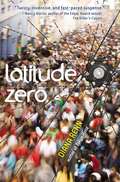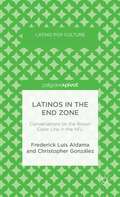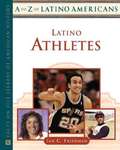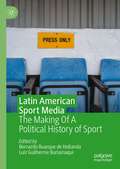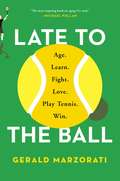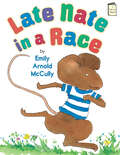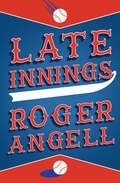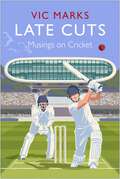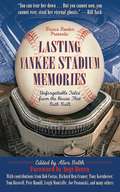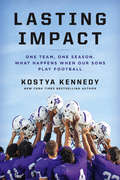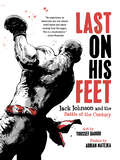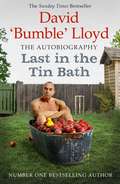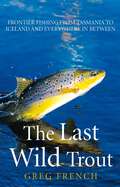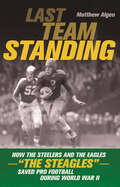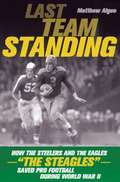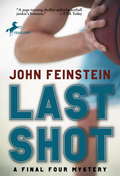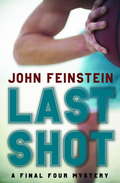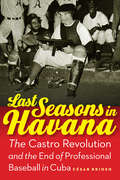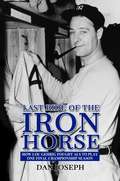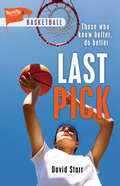- Table View
- List View
Latitude Zero
by Diana Renn"I have to run," said Juan Carlos. "You will call? Please? It is very important." "Yes. I will call. Definitely. At two." That's what Tessa promises. But by two o'clock, young Ecuadorian cycling superstar Juan Carlos is dead, and Tessa, one of the last people ever to speak to him, is left with nothing but questions. The media deems Juan Carlos's death a tragic accident at a charity bike ride, but Tessa, an aspiring investigative journalist herself, knows that something more is going on. While she grapples with her own grief and guilt, she is being stalked by spies with an insidious connection to the dead cycling champion. Tessa's pursuit of an explanation for Juan Carlos's untimely death leads her from the quiet New England backwoods to bustling bike shops and ultimately to Ecuador itself, Juan Carlos's homeland. As the ride grows bumpy, Tessa no longer knows who's a suspect and who is an ally. The only thing she knows for sure is that she must uncover the truth of why Juan Carlos has died and race to find the real villain--before the trail goes cold.
Latinos in the End Zone: Conversations on the Brown Color Line in the NFL
by Frederick Luis Aldama Christopher GonzálezFrederick Luis Aldama and Christopher Gonzalez offer a thought-provoking conversation on the history of Latinos in the pro football leagues. As they weave their way through significant points where culture, politics, and history congeal, Aldama and Gonzalez thread together an alpha-to-omega, all-encompassing story of Latinos in the NFL.
Latino Athletes
by Ian C. FriedmanA book about 175 Latinos who have made significant accomplishments in athletics in the U.S. and the world.
Latin American Sport Media: The Making Of A Political History of Sport
by Bernardo Buarque de Hollanda Luiz Guilherme BurlamaquiThis book provides an historical overview of the formation of sports media in Latin America and its role in the construction of the political history of Latin American sport. The sports press was a privileged observer of the development of modern sports, but it was also a key factor in the making of professional sports in Latin America. Most of the literature on sport in Latin America treats the sports press as an historical source, rarely taking it as an object of study in itself. However, the development of sports in the region is connected to national and state-building processes and the role of media narratives is crucial to understanding how sports participate in those processes. Spanning the globalization of football in the late nineteenth century to the shift promoted by television in the 1970s, the chapters survey the historical development of sports media in Latin America. Representing ten countries, the contributors follow a framework that presents the press not as a passive narrator of the sports phenomenon, but as a social agent of the sports field. This book is of use to those interested in the history of sports and the media, and it will be a good resource for undergraduates taking courses on Sports History, Latin American History, Sports Management, and Journalism and Communication.
Lateral Ankle Instability: An International Approach by the Ankle Instability Group
by James Calder Jón Karlsson Hélder Pereira Stéphane Guillo Mark Glazebrook Masato Takao Niek Van DijkThis superbly illustrated, up-to-date reference textbook covers all aspects of ankle instability and its management. Readers will find extensive information on biomechanics, injury prevention, current strategies for conservative treatment, and established and emerging surgical techniques. The most recent procedures, particularly those which are minimally invasive and arthroscopically assisted, are described and discussed in depth. Detailed attention is also devoted to controversies such as the indications and timing for conservative or surgical treatment, the current and future roles of arthroscopy, the definition of “anatomic” repair, and the upcoming concept of “anatomic reconstruction” (replication of anatomy by using a graft). The book is published in cooperation with ESSKA, and the chapter authors include clinicians and scientists working in the field of foot and ankle orthopaedics and sports medicine from across the world. All who are involved in the care of patients suffering from ankle instability, including amateur and high-level athletes, will find Lateral Ankle Instability to be an excellent source of knowledge and a valuable aid to clinical practice.
Late to the Ball: A Journey into Tennis and Aging
by Gerald MarzoratiAn award-winning author attempts to become a nationally competitive tennis player—at the age of sixty—in this “soulful meditation on aging, companionship, and the power of self-improvement” (The Wall Street Journal).Being a man or a woman in your early sixties is different than it was a generation or two ago, at least for the more fortunate of us. We aren’t old…yet. But we sense it coming: Careers are winding down, kids are gone, parents are dying (friends, too), and our bodies are no longer youthful or even middle-aged. Learning to play tennis in your fifties is no small feat, but becoming a serious, competitive tennis player at the age of sixty is a whole other matter. It requires training the body to defy age, and to methodically build one’s game—the strokework, footwork, strategy, and mental toughness. Gerry Mazorati had the strong desire to lead an examined physical life, to push his body into the “encore” of middle age. In Late to the Ball Mazorati writes vividly about his difficulties, frustrations, and triumphs of becoming a seriously good tennis player. He takes on his quest with complete vigor and absolute determination to see it through, providing a rich, vicarious experience, involving the science of aging, his existential battle with time, and the beautiful, mysterious game of tennis. “Enjoyable…crisp and clean” (Publishers Weekly), Late to the Ball is also captivating evidence that the rest of the Baby Boomer generation, now between middle age and old age, can find their own quest and do the same.
Late Nate in a Race (I Like to Read)
by Emily Arnold McCullyOn the day of the race, Nate is running late. Find out what happens when he tries out going fast in this Guided Reading Level D story. Nate likes to go slow. His brother and sister are worried they'll miss the race—but mom tells them not to nag him. When they get there, Mom convinces Nate to try, too. . . . And Nate finds out sometimes he likes to go slow, but sometimes he likes to go fast! With colorful, kid-friendly illustrations by Caldecott Honor artist Emily Arnold McCully, this simple story about the rewards of trying new things is perfect for emergent readers. The award-winning I Like to Read® series focuses on guided reading levels A through G, based upon Fountas and Pinnell standards. Acclaimed author-illustrators--including winners of Caldecott, Theodor Seuss Geisel, and Coretta Scott King honors—create original, high quality illustrations that support comprehension of simple text and are fun for kids to read with parents, teachers, or on their own! Suitable for late kindergarten readers, Level D books feature wider vocabulary, longer sentences, and greater variety in sentence structure than levels A, B, and C. When Level D is mastered, follow up with Level E.
Late Innings: A Baseball Companion
by Roger AngellCovers the 5 seasons of baseball, from 1977 to 1981, a time of immense popularity for baseball.
Late Innings
by Roger AngellThe acclaimed New Yorker sportswriter examines the inner working of professional baseball, in these essays from the spring of 1977 to the summer of 1981.Late Innings takes fans far beyond the stadium view of the field and into the substrata of baseball as it is experienced by the people who make it happen. Celebrated as one of the game&’s finest chroniclers, Roger Angell shares his commentary on the money, fame, power, traditions, and social aspects of baseball during the late seventies and early eighties. Covering monumental events such as Reggie Jackson&’s three World Series home runs and the bitter ordeal of the 1981 players&’ strike, Angell offers a timeless perspective on the world of baseball to be enjoyed by fans of all ages.
Late Cuts: Musings on Cricket
by Vic MarksFrom Somerset stalwart to acclaimed writer and broadcaster, Vic Marks has lived a life steeped in cricket. In Full Marks he takes us beyond the boundary rope, sharing the parts of the game fans don't get to see, from the food served at tea-time (then: sweaty ham. Now: quinoa, cranberry and feta salad) to the politics of the dressing room. With chapters on what it feels like to be dropped, how to be a good twelfth man, captaincy, selection and more, this amusing and insightful collection will delight all cricket lovers.
Lasting Yankee Stadium Memories: Unforgettable Tales from the House That Ruth Built
by Alex BelthIn Lasting Yankee Stadium Memories, editor Alex Belth of BronxBanterBlog.com collects personal essays by some of the most well-known and respected voices in sportswriting and entertainment today. In these revealing, sometimes hilarious, oft-touching essays, the contributors recount their favorite moments inside the most famed of all American stadiums. The book also includes a special chapter on the new Yankee Stadium. Contributors include: Bob Costas (NBC, HBO) * Richard Ben Cramer * Pete Hamill * Tony Kornheiser (ESPN) * Tom Boswell (Washington Post) * Dave Kindred (Washington Post) * Leigh Montville (Sports Illustrated) * William Nack (Sports Illustrated) * Joe Posnanski (Sports Illustrated) * Jane Leavy * Pat Jordan * Maury Allen (New York Post) * Bob Klapisch (Bergen Record) * Tyler Kepner (New York Times) * Allen Barra (Wall Street Journal) * Marty Appel * Jeff Pearlman * Alan Schwarz (New York Times) * Charles Pierce (Boston Globe) * Steve Rushin (Sports Illustrated) * Nathan Ward * Mike Vaccaro (New York Post) * Rob Neyer (ESPN.com) * Ken Rosenthal (ESPN) * Scott Raab (Esquire) * Luis Guzman
Lasting Impact: One Team, One Season. What Happens When Our Sons Play Football
by Kostya KennedyNew York Times bestselling author Kostya Kennedy sets this captivating, character-rich story against the back-drop of one of the most pressing questions in sports: Should we let our sons play football? At the high end of America's most popular game is the glittering NFL, a fan-stoked money machine and also an opaque enterprise under scrutiny for the physical dangers imposed on its players. Then there's high school football, unrivaled for the crucial life lessons it imparts-discipline, leadership, cooperation, humility, perseverance-yet also a brain-rattling, bone-breaking game whose consequences are at best misunderstood, and, at the very worst, deadly. What is the parent of a young athlete to make of that?The New Rochelle High School team in suburban New York is like many across the country: a source of civic pride, a manhood workshop for a revered coach and an emotional proving ground for boys of widely different backgrounds. In the fall of 2014, New Rochelle's season unfolded alongside watershed NFL head injury revelations and domestic abuse cases (remember Ray Rice?), as well as fatalities on nearby fields.The dramatic story of that season, for players, parents and coaches, underscores fundamental questions. Are football's inherent risks so great that the sport may not survive as we know it? Or are those risks worth the rewards that the game continues to bestow, and that can stay with a young man for a lifetime?
Last on His Feet: Jack Johnson And The Battle Of The Century
by Adrian Matejka Youssef DaoudiA groundbreaking graphic portrait of boxing legend Jack Johnson, Last on His Feet offers a front-row seat to the Battle of the Century. On the morning of July 4, 1910, thousands of boxing fans stormed a newly built stadium in Reno, Nevada, to witness an epic showdown. Jack Johnson, the world’s first Black heavyweight champion—and most infamous athlete in the world because of his race—was paired against Jim Jeffries, a former heavyweight champion then heralded as the “great white hope.” It was the height of the Jim Crow era, and spectators were eager for Jeffries to restore the racial hierarchy that Johnson had pummeled with his quick fists. Transporting readers directly into the ring, artist Youssef Daoudi and poet Adrian Matejka intersperse dramatic boxing action with vivid flashbacks to reveal how Johnson, the self-educated son of formerly enslaved parents, reached the pinnacle of sport—all while facing down a racist justice system. Through a combination of breathtaking illustrations and striking verse, Last on His Feet honors a contentious civil rights figure who has for more than a century been denied his proper due.
Last in the Tin Bath
by David LloydWith his infectious enthusiasm for the game, David 'Bumble' Lloyd is one of the most popular cricket commentators around, blending immense knowledge and experience with an eye for the quirky detail and an unending fund of brilliant stories. This new autobiography recalls his childhood in Accrington, Lancashire, when, after a long day playing cricket in the street, he would get his chance to wash himself in his family's tin bath - but only after his parents and uncle had taken their turn first. From there he moved on to make his debut for Lancashire while still in his teens, eventually earning an England call-up, when he had to face the pace of Lillee and Thomson - with painful and eye-watering consequences. After retiring as a player, he became an umpire and then England coach during the 1990s, before eventually turning to commentary with Sky Sports. Packed with hilarious anecdotes from the golden age of Lancashire cricket, and behind-the-scenes insight into life with England and on the Sky commentary team, Bumble's book is a joy to read from start to finish.
Last Wild Trout
by Greg FrenchThe Last Wild Trout is an entertaining and intrepid adventure seeking out the last truly wild trout fisheries around the world. Casting his line in 20 far-flung locations, Greg takes in Tasmania, New Zealand, Iceland, the British Isles, Mongolia, Slovenia, British Columbia, Wyoming, California, Patagonia, Nevada, Alaska and Hokkaido all in search of the species that can still be called wild trout. Each chapter in this evocative and beautifully-illustrated book focuses on one species or subspecies of trout, and includes a compelling human narrative in Greg’s gregarious and inimitable style. With the deft touch of an expert fisher, Greg beautifully balances the scientific with the personal, the practical with reverie, and the conservation with travel narrative.
Last Wild Trout
by Greg FrenchTrout are found in some of the most wild, romantic and scenically diverse habitats on Earth, and fly fishers the world over share a unique camaraderie, something universally profound and sincere. In The Last Wild Trout, Greg French explores the last truly great and most coveted trout fisheries left on the planet. Roaming the final frontiers of trout fishing, Greg visits twenty locations including Tasmania, New Zealand, Iceland, the British Isles, Mongolia, Slovenia, British Columbia, Wyoming, California, Nevada and Hokkaido. Each chapter deals with a unique species or subspecies of wild trout, and tells a compelling human narrative set against a backdrop of conservation. Photo sections and taxonomy notes complete the picture in this fascinating book. Reflecting on the complexity of humanity's interactions with pristine natural environments and threatened fisheries, The Last Wild Trout is a reminder from one of the world's best fishing writers of the beauty and importance of nature in all of our lives.
Last Team Standing: How the Steelers and the Eagles—"The Steagles"—Saved Pro Football During World War II
by Matthew AlgeoTracing the history of the National Football League during World War II, this book delves into the severe player shortage during the war which led to the merging of the Pittsburgh Steelers and the Philadelphia Eagles, creating the "Steagles." The team's center was deaf in one ear, its wide receiver was blind in one eye (and partially blind in the other), and its halfback had bleeding ulcers. One player was so old he'd never before played football with a helmet. Yet somehow, this group of players--deemed unfit for military service due to age or physical ailment--posted a winning record in the league, to the surprise of players and fans alike. Digging into the history of the war paralleled by the unlikely story of the Steagles franchise, both sports fans and history buffs will learn about the cultural significance of this motley crew of ball players during a trying time in United States history.
Last Team Standing
by Matthew AlgeoDuring World War II, the National Football League faced a crisis unimaginable today: a shortage of players. By 1943, so many players were in the armed forces that the league was forced to fold one team (the Cleveland Rams) and merge two others: the Pittsburgh Steelers and the Philadelphia Eagles. Thus were the Steagles born. The Steagles included military draft rejects, aging stars lured out of retirement, and even a couple of active servicemen who managed to get leave for the games. The center was deaf in one ear, the wide receiver was blind in one eye (and partially blind in the other), and the halfback had bleeding ulcers. One player was so old he'd never before played football with a helmet. Yet, somehow, this motley bunch managed to post a winning record--the first in the history of the Eagles and just the second in the history of the Steelers. ButLast Team Standingisn't just about football. It's also about life in the United States during World War II, a time of fear and hope, of sacrifice and momentous change. It's about rationing, racism, and Rosie the Riveter. It's about draft boards, bond drives, the A-bomb, and movie stars. Above all, it's about the men and women of the Greatest Generation who couldn't fight, but helped win the war in immeasurable ways.
Last Team Standing
by Matthew AlgeoDuring World War II, the national Football League faced a crisis unimaginable today: a shortage of players. By 1943, so many players were in the armed forces that the league was forced to fold one team (the Cleveland Rams) and merge two others: the Pittsburgh Steelers and the Philadelphia Eagles. Thus were the "Steagles” born. The Steagles included military draft rejects, a superstar lured out of retirement, and even a few active-duty servicemen who got leave for the games. Yet, somehow, this motley crew posted a winning record-the first in Eagles’ history and the second in Steelers’ history. A book about football, about life during the war, Last Team Standing is, above all, about those of the Greatest Generation who, against all odds, contributed to America’s war effort in the unlikeliest ways.
Last Shot: A Final Four Mystery (The Sports Beat #1)
by John FeinsteinNew York Times bestselling sportswriter John Feinstein exposes the real "March Madness"--behind the scenes at the Final Four basketball tournament. When Stevie wins a writing contest for aspiring sports journalists, his prize is a press pass to the Final Four in New Orleans. While exploring the Superdome, he overhears a plot to throw the championship game. With the help of fellow contest winner Susan Carol, Stevie has just 48 hours to figure out who is blackmailing one of the star players . . . and why.
Last Shot (Final Four Mystery #1)
by John FeinsteinSteven Thomas is one of two lucky winners of the U.S. Basketball Writer's Association's contest for aspiring journalists. His prize? A trip to New Orleans and a coveted press pass for the Final Four. It's a basketball junkie's dream come true! But the games going on behind the scenes between the coaches, the players, the media, the money-men, and the fans turn out to be even more fiercely competitive than those on the court. Steven and his fellow winner, Susan Carol Anderson, are nosing around the Superdome and overhear what sounds like a threat to throw the championship game. Now they have just 48 hours to figure out who is blackmailing one of MSU's star players ... and why.
Last Seasons in Havana: The Castro Revolution and the End of Professional Baseball in Cuba
by César BriosoLast Seasons in Havana explores the intersection between Cuba and America’s pastime from the late 1950s to the early 1960s, when Fidel Castro overthrew Cuban dictator Fulgencio Batista. César Brioso takes the reader through the triumph of the revolution in 1959 and its impact on professional baseball in the seasons immediately following Castro’s rise to power. Baseball in pre‑Castro Cuba was enjoying a golden age. <P><P>The Cuban League, which had been founded in 1878, just two years after the formation of the National League, was thriving under the auspices of organized baseball. Throughout the first half of the twentieth century, players from the Major Leagues, Minor Leagues, and Negro Leagues had come to Cuba to play in the country’s wholly integrated winter baseball league. <P><P>Cuban teams had come to dominate the annual Caribbean Series tournament, and Havana had joined the highest levels of Minor League Baseball, fielding the Havana Sugar Kings of the Class AAA International League. Confidence was high that Havana might one day have a Major League team of its own. <P><P> But professional baseball became one of the many victims of Castro’s Communist revolution. American players stopped participating in the Cuban League, and Cuban teams moved to an amateur, state‑sponsored model. Focusing on the final three seasons of the Cuban League (1958–61) and the final two seasons of the Havana Sugar Kings (1959–60), Last Seasons in Havana explores how Castro’s rise to power forever altered Cuba and the course of a sport that had become ingrained in the island’s culture over the course of almost a century.
Last Ride of the Iron Horse: How Lou Gehrig Fought Als to Play One Final Championship Season
by Dan Joseph"Last Ride of the Iron Horse" tells the tale of Lou Gehrig's final year in the Yankee lineup, as he dealt with early effects of the deadly disease ALS. For much of the 1938 season, Gehrig -- dubbed the Iron Horse for his strength and reliability -- struggled with slumps and a mystifying loss of power. Fans booed and sportswriters called for him to be benched. Then, as the Yankees battled for the pennant in August, Lou began pounding home runs like his old self -- a turnaround that in retrospect looks truly miraculous. It may have been a rare case of temporary ALS reversal. Using rare film footage, radio broadcasts, newspapers and interviews, author Dan Joseph chronicles Gehrig's roller coaster of a year. The story begins in Hollywood, where the handsome "Larrupin' Lou" films a Western that would be his only movie. As the year unfolds, he holds out for baseball’s highest salary, battles injuries that would sideline a lesser man, wins his sixth World Series ring, and enters the political arena for the first time, denouncing the rising threat of Nazism. Joseph also answers questions that have long intrigued Gehrig's admirers: When did he sense something was wrong with his body? What were the first signs? How did he adjust? And did he still help the Yankees win the championship, even as his skills declined? 1938 would be Gehrig's last hurrah. With his strength fading, he ended his renowned consecutive games streak the following May. A few weeks later, doctors at the Mayo Clinic diagnosed him with ALS. On July 4th, the Yankees retired his number in a ceremony at Yankee Stadium. All along, Gehrig showed remarkable courage and grace, never more so than when he told the stadium crowd, "I might have been given a bad break, but I've got an awful lot to live for."
Last Pick (Lorimer Sports Stories)
by David StarrGrowing up with a developmental condition that left her clumsy in both movement and speech, Jazz was teased and never had the chance to play team sports. Now rid of her symptoms, Jazz is ready to play basketball at her junior high, but the reappearance of an old bully makes her question herself and tempts her to let down the team that is counting on her. Last Pick emphasizes teamwork and countering bullying with fairness and forgiveness and how determination can help overcome obstacles. Distributed in the U.S by Lerner Publishing Group
Last One In Is a Rotten Egg
by Leonard KesslerAfter Freddy is pushed into deep water by a couple of toughs, he decides to learn to swim.
